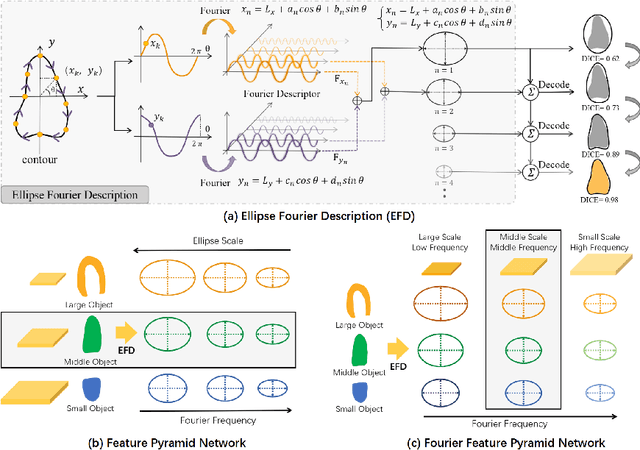Junxuan Yu
Explainable and Controllable Motion Curve Guided Cardiac Ultrasound Video Generation
Jul 31, 2024Abstract:Echocardiography video is a primary modality for diagnosing heart diseases, but the limited data poses challenges for both clinical teaching and machine learning training. Recently, video generative models have emerged as a promising strategy to alleviate this issue. However, previous methods often relied on holistic conditions during generation, hindering the flexible movement control over specific cardiac structures. In this context, we propose an explainable and controllable method for echocardiography video generation, taking an initial frame and a motion curve as guidance. Our contributions are three-fold. First, we extract motion information from each heart substructure to construct motion curves, enabling the diffusion model to synthesize customized echocardiography videos by modifying these curves. Second, we propose the structure-to-motion alignment module, which can map semantic features onto motion curves across cardiac structures. Third, The position-aware attention mechanism is designed to enhance video consistency utilizing Gaussian masks with structural position information. Extensive experiments on three echocardiography datasets show that our method outperforms others regarding fidelity and consistency. The full code will be released at https://github.com/mlmi-2024-72/ECM.
FFPN: Fourier Feature Pyramid Network for Ultrasound Image Segmentation
Aug 26, 2023



Abstract:Ultrasound (US) image segmentation is an active research area that requires real-time and highly accurate analysis in many scenarios. The detect-to-segment (DTS) frameworks have been recently proposed to balance accuracy and efficiency. However, existing approaches may suffer from inadequate contour encoding or fail to effectively leverage the encoded results. In this paper, we introduce a novel Fourier-anchor-based DTS framework called Fourier Feature Pyramid Network (FFPN) to address the aforementioned issues. The contributions of this paper are two fold. First, the FFPN utilizes Fourier Descriptors to adequately encode contours. Specifically, it maps Fourier series with similar amplitudes and frequencies into the same layer of the feature map, thereby effectively utilizing the encoded Fourier information. Second, we propose a Contour Sampling Refinement (CSR) module based on the contour proposals and refined features produced by the FFPN. This module extracts rich features around the predicted contours to further capture detailed information and refine the contours. Extensive experimental results on three large and challenging datasets demonstrate that our method outperforms other DTS methods in terms of accuracy and efficiency. Furthermore, our framework can generalize well to other detection or segmentation tasks.
Segment Anything Model for Medical Images?
May 01, 2023



Abstract:The Segment Anything Model (SAM) is the first foundation model for general image segmentation. It designed a novel promotable segmentation task, ensuring zero-shot image segmentation using the pre-trained model via two main modes including automatic everything and manual prompt. SAM has achieved impressive results on various natural image segmentation tasks. However, medical image segmentation (MIS) is more challenging due to the complex modalities, fine anatomical structures, uncertain and complex object boundaries, and wide-range object scales. Meanwhile, zero-shot and efficient MIS can well reduce the annotation time and boost the development of medical image analysis. Hence, SAM seems to be a potential tool and its performance on large medical datasets should be further validated. We collected and sorted 52 open-source datasets, and built a large medical segmentation dataset with 16 modalities, 68 objects, and 553K slices. We conducted a comprehensive analysis of different SAM testing strategies on the so-called COSMOS 553K dataset. Extensive experiments validate that SAM performs better with manual hints like points and boxes for object perception in medical images, leading to better performance in prompt mode compared to everything mode. Additionally, SAM shows remarkable performance in some specific objects and modalities, but is imperfect or even totally fails in other situations. Finally, we analyze the influence of different factors (e.g., the Fourier-based boundary complexity and size of the segmented objects) on SAM's segmentation performance. Extensive experiments validate that SAM's zero-shot segmentation capability is not sufficient to ensure its direct application to the MIS.
 Add to Chrome
Add to Chrome Add to Firefox
Add to Firefox Add to Edge
Add to Edge